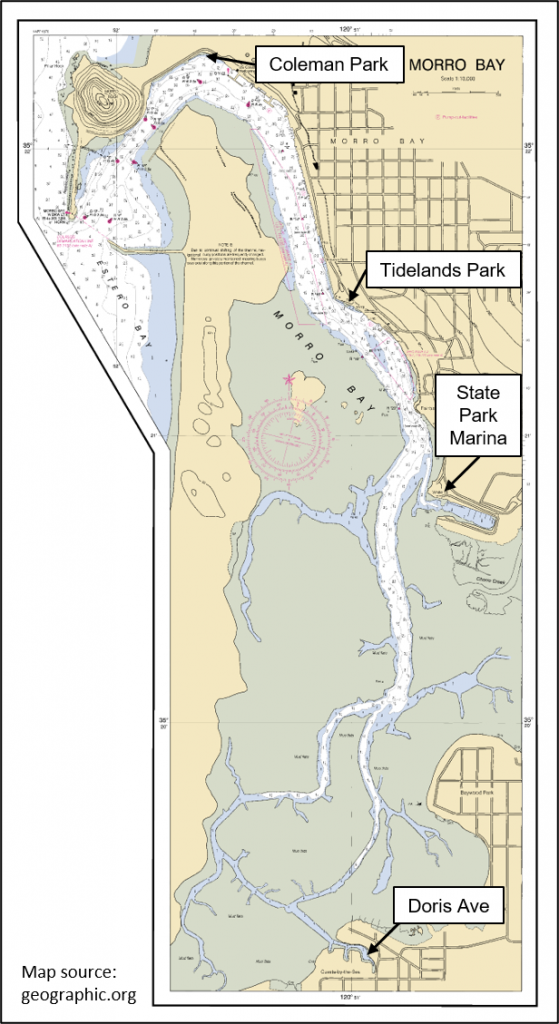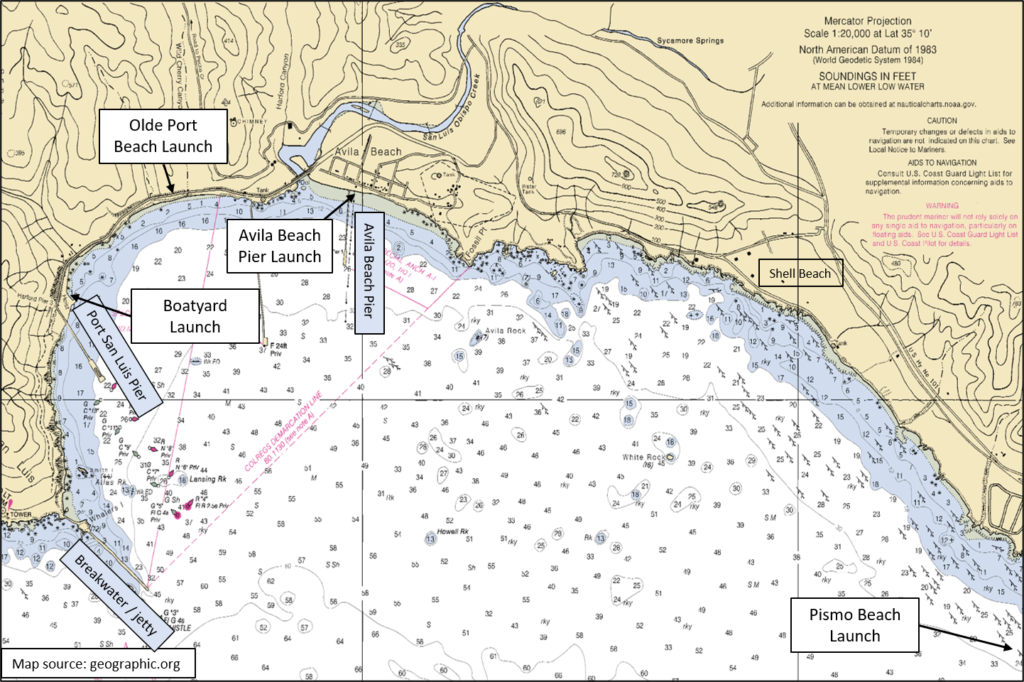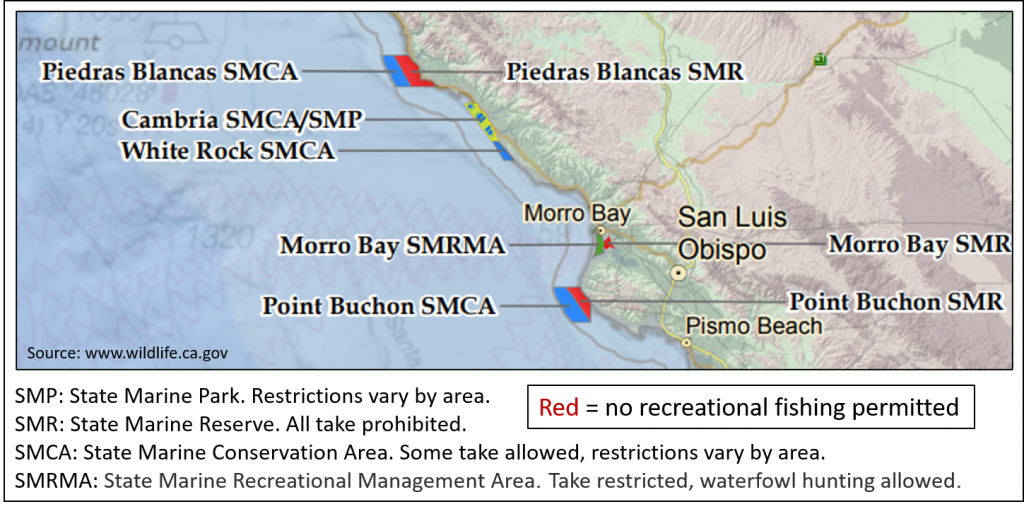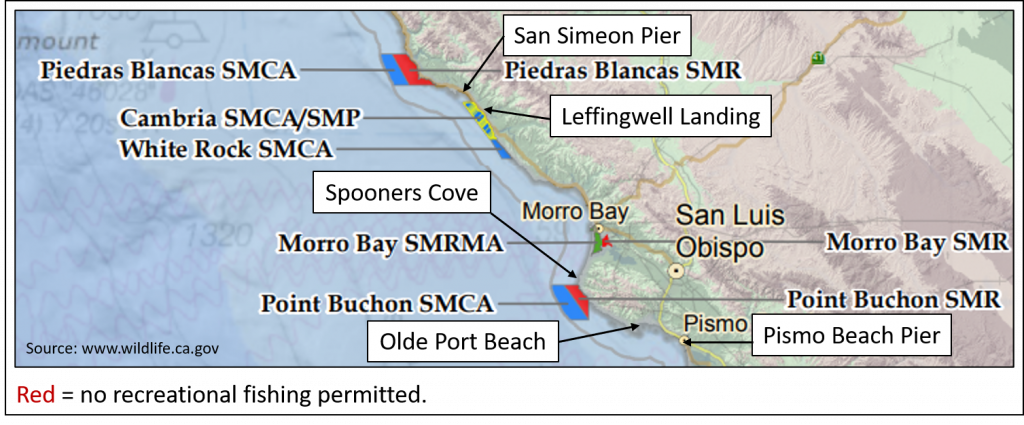Kayaking
Recreational Paddling at Morro Bay
Recreational paddling opportunities on the bay itself range from a casual perusal of the harbor to more intense wildlife-viewing in the Harbor and Estuary, to round-trip endurance paddles from the harbor to the Back Bay.
A casual tour of the Harbor provides unique views of the docks, commercial fishing operations and other waterfront businesses, and exceptional views of Sea Otters, Sea Lions, Brown Pelicans, Great Blue Herons, Gulls, and Night Herons. Alert paddlers might also observe Peregrine Falcons and Ospreys flying overhead. Swing by Windy Cove to observe nesting herons and cormorants. During the winter bird migration, you’re likely to encounter loons, grebes, and phalaropes. Be aware that during outgoing tides the current through the Harbor can be surprisingly strong.
If you’re keen to observe a greater diversity of wildlife, extend your paddle to the Morro Bay Estuary (the harbor is best for deep water species). Be aware that the estuary is shallow, and knowledge of the meandering channels is helpful, if not essential. Embark on an incoming tide and return before the outgoing tide leaves you stranded. On most visits to the Estuary you will encounter Harbor Seals, pelicans, cormorants, herons, egrets, sandpipers, and shore crabs. During the winter bird migration, you’re likely to encounter White Pelicans, Pacific Brant, and several species of ducks and sandpipers, numbering in the thousands.
If your objective is to see the full length of the bay, and possibly visit remote patches of marsh vegetation along the Sand Spit, you’ll want to coordinate your paddle with the tide cycle. The entire Back Bay is quite shallow, and only a few branch channels extend toward the Sand Spit. You should embark on an incoming tide, and head back before the outgoing tide leaves you stranded on a mudflat. An excursion to the Back Bay is best done in the company of a knowledgeable local paddler or guide. A shallow draft kayak or canoe is essential; paddleboards excel in shallow water.
Morro Bay Kayak Launches

Morro Bay Kayak and Paddleboard Rentals
Morro Bay Kayak Guide Services
Recreational Paddling at San Luis Obispo Bay
San Luis Obispo Bay is just 30 minutes south of The Birdhouse. Because of its greater depth, direct connection to the ocean, and towering cliffs and sea stacks, wildlife habitats and recreational opportunities differ somewhat from those at Morro Bay.
Some of the physical attractions of SLO Bay include the Port San Luis breakwater, piers at Port San Luis and Avila Beach, seas stacks (Smith Rock, Avila Rock, White Rock, to name a few), and the towering sea cliffs and arches between Avila Beach and Pismo Beach. On calm days, the historic Port San Luis Lighthouse can be accessed by kayak (outside the breakwater). Depending on tidal conditions, the arches at Dinosaur Caves Park (Pismo Beach) can sometimes be entered by kayak.
The best wildlife viewing occurs near sea stacks and rock jetties (breakwaters). These structures provide relatively undisturbed respites for wildlife to rest and nest. Sea Lions and Harbor Seals haul out to bask on these structures, and Sea Otters frolic in nearby kelp beds. In spring and summer, a wide variety of birds nests on the sea stacks, including gulls, Brown Pelicans, Brandt’s and Pelagic Cormorants, Pigeon Guillemots, and Black Oystercatchers. During winter migration, loons, grebes, and a variety of diving ducks ply the bay’s sheltered waters.
SLO Bay Kayak Launches
The best launch facilities are located at the Port San Luis Boatyard (3915 Avila Beach Dr), Old Port Beach (Avila Beach Road, Avila Beach, 300 ft west of Wild Cherry Canyon), Avila Beach Pier (300 & 500 blocks of Front Street), and the end of Main Street, Pismo Beach. The public launch at the boatyard is located behind Avila Beach Paddlesports. It is the easiest launch on the bay because you launch from a dock. It is the nearest launch to the lighthouse, main breakwater, San Luis Pier, and Smith Rock. The launch at Old Port Beach has relatively calm surf, but is a surf launch, nonetheless. The cliffs at Shell Beach will be about a 1-mile paddle away, but perhaps a minor tradeoff if you want to avoid launching through waves. The launch at Avila Beach Pier is located midway between Port San Luis Pier and the cliffs and arches at Shell Beach, and either area can be reached within a short paddle. The Avila Pier is less sheltered however, and you will be launching through waves. Parking at Avila beach Pier is also more congested. The Main Street Launch at Pismo Beach is considerably further south, and is preferred only for accessing the sea arches at Dinosaur Caves Park and the cliffs at Shell Beach, although it is possible to access all of SLO Bay from Pismo if you have the time and stamina. This launch is unsheltered, and usually entails launching through moderate surf.
SLO Bay Launch Locations

SLO Bay Kayak and Paddleboard Rentals
SLO Bay Kayak Guide Services
Kayak Fishing
The information provided here is for kayak fishing along the Central Coast from San Simeon to Pismo Beach, an area that includes Morro Bay, San Luis Obispo Bay, and approximately 50 miles of coastline. See our Fishing page for information for other types of fishing. There are several Marine Protected Areas (MPAs) in this region, where fishing is either prohibited or strictly regulated. It is essential to know where each is located and the rules that apply. Exact locations and regulations specific to each area can be found at CDFW’s Marine Protected Areas Webpage.
Marine Protected Areas in the Region

Be aware that given Morro Bay’s Marine Protected Area status, only finfish – bony fish and cartilaginous fish – may be taken anywhere within the bay. Any crab, shrimp, octopus, or clam you catch must be released.
Kayak Fishing at Morro Bay
Fishing within Morro Bay varies by location. The entrance to the bay, lying between Morro Rock and the breakwater jetties, has a coarse sandy bottom, and is inhabited by several species of perch and flatfish. The harbor and marina areas have a mud-sand bottom, relatively deep channel, pier pilings, and scattered patches of kelp and eelgrass. In addition to a variety of perch and flatfish species, the area is inhabited by Cabezon, Lingcod, sharks, rays, and a variety of rockfish and flatfish. In summer, the harbor is visited by schools of sardines, anchovies, and smelt. The rockfish, Cabazon, Lingcod, and halibut caught here are generally smaller than adults taken from boats out it deeper water. Shallower regions of the bay, south of White Point (the Natural History Museum) and north of Baywood Park, have a silty-mud bottom, narrow channels, and extensive beds of eelgrass. Here, the primary gamefish species are various sharks and rays, perch, and flatfish. No fishing of any kind is allowed in the Back Bay (south of a line extending west from Baywood Park – specifically latitude 35 °19.70′ N) or the Estuary (east of a line extending north from Baywood Park – specifically longitude 120° 50.340′ W). If you plan to fish near these boundaries, be sure to carry a device that displays your real-time coordinates.
Morro Bay Fish Species by Location
Fishing in Morro Bay also varies by season. Resident species are taken through the year, including various perch species, flatfish, rockfish, sharks, and rays. Rockfish tend to be mid-sized (because adults move out to deeper water). In summer, other species and size-classes occur in, or move into, the bay, including schooling perch species, immature rockfish, mid-sized Cabezon and Lingcod, California Halibut, and large schools of pelagic “baitfish” including Pacific Sardines, Jacksmelt, Pacific Mackerel, or Jack Mackerel. Note that there are minimum size limits for Lingcod, Cabezon, and California Halibut.
Kayak Fishing at San Luis Obispo Bay
There are several types of fishing environments available at SLO Bay: kelp beds, sea stacks, rocky subtidal, sandy subtidal, breakwaters and jetties, pier pilings, open water, and inshore reefs. The most extensive rocky tidal/subtidal zone extends from Avila Beach south to Pismo Beach. Sea stacks occur throughout bay. The kelp beds are often associated with rocky subtidal habitats and sea stacks. Gamefish species typically associated with the bay’s rocky subtidal zone and kelp beds include small to mid-sized rockfish (especially Brown, Copper, Blue, Olive, and Bocaccio), greenling, kelp (calico) bass, small to mid-sized Lingcod and Cabazon, and a variety of perch. Rock jetties and pier pilings support a variety of perch and smaller rockfish. Typical rigging for rocky areas and kelp beds include: 1) a standard rockfish rig baited with cut bait (squid, sardine, anchovy), plastic swimbaits, or a combination of the two, 2) a plastic swimbait on a leadhead jig, often with a strip of squid attached, and 3) a rockfish rig baited with live bait (sardine, anchovy, mussel, blood worm, ghost shrimp), when available. Areas with sandy bottoms occur throughout the bay, most noticeably offshore from the sandy beaches at Avila Pier and Olde Port Beach. Gamefish species inhabiting these areas include flatfish (sanddabs, sole, flounder, halibut), croaker, and mid-depth perch species. Halibut within the bay tend to be under the legal size limit. Sandy-bottomed areas are typically fished by drifting with whole squid, live finbait, or slug swimbait on a leadhead jig or Carolina rig. Pier pilings and rock jetties (south of Port San Luis Pier) offer mostly a variety of perch species and smaller rockfish. In summer, open waters of the bay are inhabited by schooling pelagic “baitfish,” including Pacific Sardines, Jacksmelt, Pacific Mackerel, or Jack Mackerel. The larger species will strike almost any silvery lure. Or you can use a sabiki rig to “make” your own live bait for rockfish rigs, or for fly-lining the occasional barracuda that might be pursuing the baitfish.
Bait and tackle suggestions for SLO Bay
Kayak Fishing the San Luis Obispo Coast
California’s Central Coast offers several inshore fishing environments, including rocky subtidal, sandy subtidal, kelp beds, and piers. Subtidal areas with rocky bottoms are home to a variety of rockfish (Bocaccio, Treefish, Brown, Canary, Copper, Gopher, Vermillion), as well as Cabazon, Lingcod, Whitefish, and a variety of perch. Typical rigging for rocky areas include: 1) a standard rockfish rig baited with cut bait (squid, sardine, anchovy), plastic swimbaits, or a combination of the two, 2) a plastic swimbait on a leadhead jig, often with a strip of squid attached, and 3) a rockfish rig baited with live bait (sardine, anchovy, mussel, blood worm, ghost shrimp), when available. Many inshore kayak fishermen “make” their own live finbait by catching small fish with a sabiki rig. Kelp beds, which are usually associated with a rocky bottom, support a variety of rockfish (Olive, Blue, Kelp), as well as Kelp (Calico) Bass, perch, and greenlings. Rigging for kelp beds can be similar to that used for rocky-bottomed areas. Casting with plastic swimbaits can also be effective. Kelp beds are good locations to catch finbait with a sabiki rig. Weedless hooks can be used to reduce snagging of kelp. Sandy-bottom areas are inhabited primarily by flatfish (Sanddab, Sand Sole, Starry Flounder, Diamond Turbot, California Halibut) and certain perch. Sandy-bottomed areas are typically fished by drifting with whole squid, live finbait, or slug swimbait on a leadhead jig or Carolina rig. Piers are generally built on sandy beaches. Fishing around the pilings will produce perch (rainbow and silver surfperch, pile perch, rubberlip seaperch, calico surfperch), and small rockfish primarily, but larger predatory fish can also show up, such as halibut and sole. There might also be a nearby kelp or eelgrass bed that will diversity the kinds of fish. Because fish around piers are generally smaller, smaller hooks should be used.
Popular Coastal Kayak Launches

